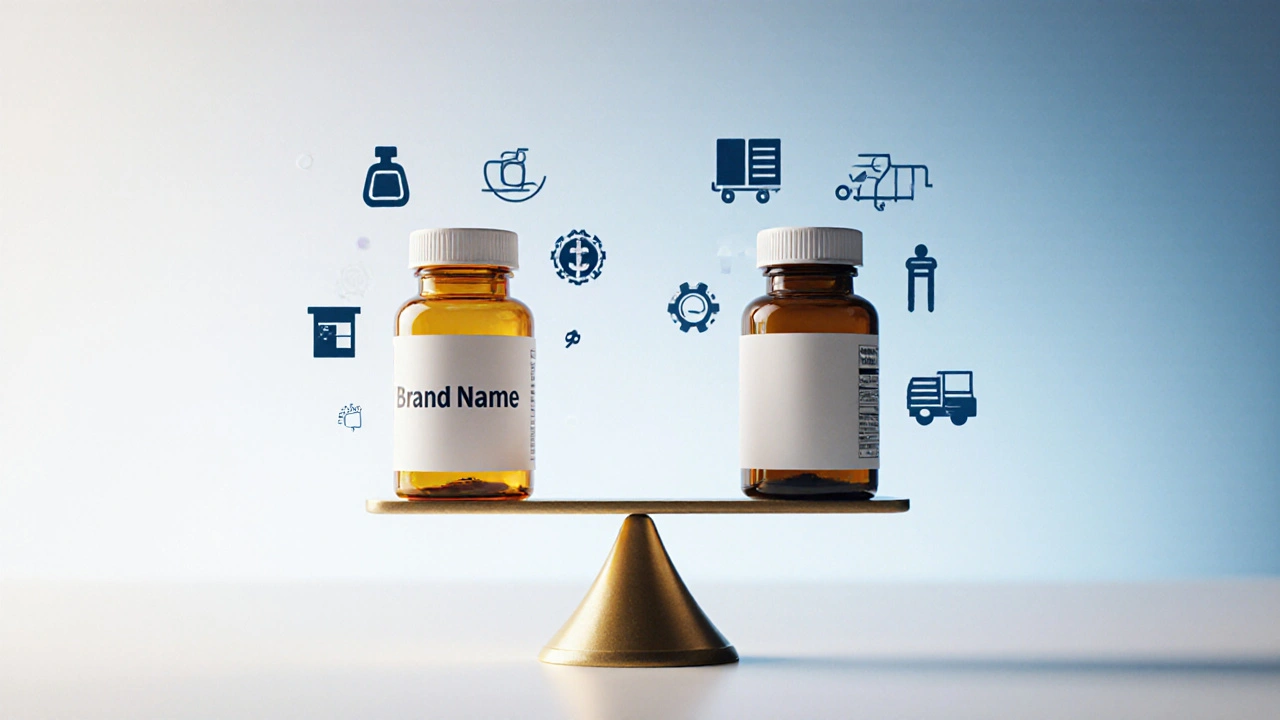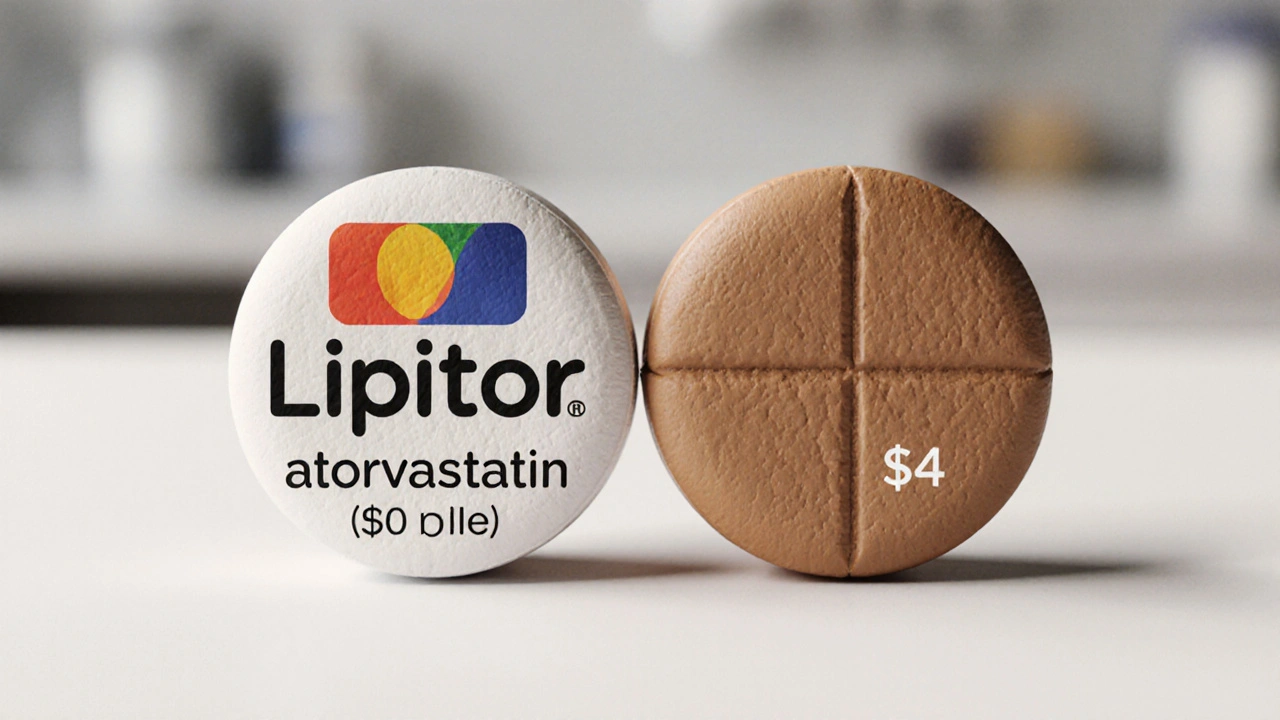When you pick up a prescription, you might see two pills that look almost identical-one with a brand name like Lipitor, another with no name at all, just the drug: atorvastatin. One costs $15. The other costs $4. You wonder: is the cheaper one really the same? The answer isn’t always obvious, especially when you hear terms like "authorized generic." So here’s the straight truth: authorized generics are not just similar to brand-name drugs-they’re the exact same medication, made in the same factory, with the same ingredients, under the same quality controls. The only difference? The label.
What Exactly Is an Authorized Generic?
An authorized generic is a brand-name drug that’s sold without the brand name on the bottle or box. It’s not a copy. It’s not a knockoff. It’s the real thing, produced by the original manufacturer-sometimes even on the same production line. The U.S. Food and Drug Administration (FDA) defines it clearly: "Other than the fact that it does not have the brand name on its label, it is the exact same drug product as the branded product."
This isn’t some loophole. It’s built into U.S. drug law. The Hatch-Waxman Act of 1984 created a system where brand companies could protect their patents, but also allowed them to launch their own generic version when the patent was about to expire. Why? To compete with other generics. It’s a business move-but it also gives patients a trusted alternative.
Unlike typical generics, which go through the Abbreviated New Drug Application (ANDA) process and must prove they’re "bioequivalent" to the brand, authorized generics skip that step entirely. They’re approved under the original brand’s New Drug Application (NDA). That means they don’t appear in the FDA’s Orange Book, which only lists ANDA-approved generics. But that doesn’t mean they’re less regulated. They’re held to the same strict standards for purity, strength, and quality as the brand.
How Are Authorized Generics Different From Regular Generics?
Here’s where things get confusing. Most people think all generics are the same. They’re not.
Regular generics are made by different companies. They must contain the same active ingredient as the brand, and they must be absorbed into the body at the same rate and to the same extent. But they can-and often do-have different inactive ingredients. That means different fillers, dyes, binders, or coatings. For most people, this doesn’t matter. But for some, it can. A person with a rare allergy to a dye might react to one generic but not another. Or someone on a narrow therapeutic index drug-like warfarin or levothyroxine-might feel a subtle difference when switching between brands.
Authorized generics don’t have that issue. They use the exact same inactive ingredients as the brand. No substitutions. No changes. Same pill, same color, same shape (as close as trademark laws allow), same manufacturing process. If you’ve ever switched from a brand to a generic and felt like something was "off," it might have been the fillers-not the active drug.
And here’s something most patients don’t know: authorized generics are often priced between the brand and the cheapest generic. Not always cheaper than all generics, but usually cheaper than the brand. That makes them a smart middle ground-especially if you’ve had bad experiences with other generics.
Do They Work the Same? The Evidence
Some people worry that even if the ingredients are the same, maybe the manufacturing isn’t. Maybe the batch is slightly different. But the FDA doesn’t allow that. Every batch-whether it’s branded or an authorized generic-must meet the same exacting standards. The agency inspects factories, reviews production data, and monitors adverse events for both.
A 2018 study published in PMC looked at over 5,000 patients who switched from brand-name drugs to generics. The study used authorized generics as a proxy for the original brand because they’re identical. The results? No meaningful difference in hospital visits, emergency room trips, or medication discontinuation rates. Patients on authorized generics stopped taking their meds at a rate of 18.7%. Those on typical generics? 19.3%. The difference was statistically insignificant.
Even the FDA’s own analysis of absorption rates found that the average difference between brand and generic drugs was just 3.5%. That’s within the 80-125% bioequivalence range the FDA considers safe. Authorized generics? They’re even closer-because they’re the same product.
Dr. Janet Woodcock, former head of the FDA’s drug evaluation center, put it plainly: "Authorized generics provide the same therapeutic effect as the brand-name product."

Why Aren’t They Listed in the Orange Book?
This trips up a lot of pharmacists and patients. If authorized generics are the same as brands, why don’t they show up in the FDA’s Orange Book? Simple: because they’re not approved under the ANDA process. The Orange Book only lists generics that went through that route. Authorized generics are marketed under the brand’s original NDA, so they’re not included.
That means your pharmacy’s system might list them as a separate product, even though they’re identical to the brand. You might see three versions of atorvastatin: the brand, a typical generic, and an authorized generic-all with different National Drug Codes (NDCs). Your insurance might cover one but not the other. Your pharmacist might need to manually override a system to substitute it.
That’s why clear communication matters. If your doctor writes "dispense as written" or "no substitution," it’s not because they doubt generics. It’s because they know you’ve had a bad experience with a different formulation. Ask your pharmacist: "Is this an authorized generic?" They can tell you.
Who Should Consider Authorized Generics?
You don’t need to be a medical expert to know when an authorized generic might be right for you.
- If you’ve switched from a brand to a generic and noticed side effects-like dizziness, nausea, or mood changes-try asking for the authorized version. The inactive ingredients might be the culprit.
- If you’re on a drug with a narrow therapeutic index (like thyroid meds, seizure drugs, or blood thinners), you might want the consistency an authorized generic offers.
- If cost is a concern but you’re wary of typical generics, authorized generics often cost 30-50% less than the brand, and sometimes only a few dollars more than the cheapest generic.
- If you’re on birth control or other medications where consistency matters for effectiveness, many patients report better outcomes with authorized generics because the formulation hasn’t changed.
It’s not about being picky. It’s about finding what works for your body.

Market Trends and Regulatory Changes
As of 2023, authorized generics make up about 5-7% of the U.S. generic drug market. That’s small compared to the 90% of prescriptions filled with generics overall, but growing. Why? Because patients and providers are becoming more aware of the differences between generic types.
The FDA has been pushing for more transparency. In 2022, they launched GDUFA III, which includes new rules to make authorized generics easier to track. In 2023, they updated labeling guidance to ensure authorized generics match brand labeling exactly-except for the brand name.
But there’s controversy. Some brand companies introduce an authorized generic at the same time they file lawsuits to delay other generics. This tactic, called a "authorized generic strategy," keeps the market divided and can delay the lowest-cost options. The Government Accountability Office flagged this in 2020 as a potential barrier to competition.
Still, for patients, the benefit remains clear: you get the same drug you’ve been taking, at a lower price, without the uncertainty of a new formulation.
What to Do Next
If you’re on a brand-name drug and want to save money, here’s what to do:
- Ask your pharmacist: "Is there an authorized generic for this medication?" They can check their system or call the manufacturer.
- Check your insurance formulary. Some plans cover authorized generics at a lower tier than the brand.
- If you’ve had side effects with other generics, ask your doctor to specify "authorized generic only" on the prescription.
- Don’t assume all generics are equal. Ask for the name of the manufacturer. If it’s the same company that makes the brand, it’s likely an authorized generic.
There’s no reason to fear authorized generics. They’re not a compromise. They’re the original drug, stripped of the brand name and the brand price tag. If you’ve been hesitant to switch to generics because you didn’t trust them, this might be the version you’ve been waiting for.
Are authorized generics as safe as brand-name drugs?
Yes. Authorized generics are made by the same manufacturer, in the same facility, using the same ingredients and quality controls as the brand-name drug. The FDA holds them to the exact same standards. There is no difference in safety, effectiveness, or quality.
Why are authorized generics sometimes more expensive than regular generics?
Because they’re produced by the brand company, they often don’t face the same level of price competition as typical generics made by multiple manufacturers. While they’re cheaper than the brand, they may cost slightly more than the lowest-priced generic. But they offer consistency-no formulation changes, no new fillers-which many patients value.
Can I ask my doctor to prescribe an authorized generic?
Yes. You can ask your doctor to write "dispense as written" or specify "authorized generic only." Pharmacists can then fill the prescription with the authorized version. This is especially helpful if you’ve had issues with other generics or are on a drug where consistency matters.
Do authorized generics appear in the FDA’s Orange Book?
No. The Orange Book only lists generics approved under the Abbreviated New Drug Application (ANDA) process. Authorized generics are approved under the original brand’s New Drug Application (NDA), so they’re not included. That doesn’t mean they’re not equivalent-it just means they’re tracked differently.
Are authorized generics available for all brand-name drugs?
No. Only brand companies can choose to launch an authorized generic, usually when their patent is about to expire. Not all brands do this. Availability depends on the manufacturer’s business strategy. Check with your pharmacist or use the FDA’s website to search for authorized generic options for your medication.

